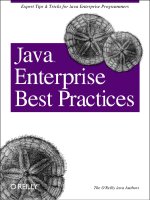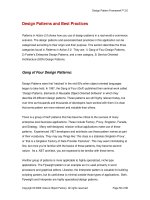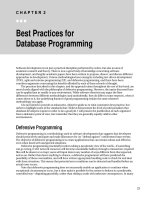Struts Survival Guide – Basics to Best Practices pptx
Bạn đang xem bản rút gọn của tài liệu. Xem và tải ngay bản đầy đủ của tài liệu tại đây (380.71 KB, 47 trang )
W
W
o
o
r
r
k
k
i
i
n
n
P
P
r
r
o
o
g
g
r
r
e
e
s
s
s
s
C
C
o
o
m
m
p
p
a
a
n
n
i
i
o
o
n
n
W
W
o
o
r
r
k
k
b
b
o
o
o
o
k
k
2
3
S
S
t
t
r
r
u
u
t
t
s
s
S
S
u
u
r
r
v
v
i
i
v
v
a
a
l
l
G
G
u
u
i
i
d
d
e
e
B
B
a
a
s
s
i
i
c
c
s
s
t
t
o
o
B
B
e
e
s
s
t
t
P
P
r
r
a
a
c
c
t
t
i
i
c
c
e
e
s
s
C
C
o
o
m
m
p
p
a
a
n
n
i
i
o
o
n
n
W
W
o
o
r
r
k
k
b
b
o
o
o
o
k
k
Srikanth Shenoy
Austin
4
ObjectSource LLC books are available for bulk purchases for corporations and other organizations. The publisher offers discounts
when ordered in bulk. For more information please contact:
Sales Department
ObjectSource LLC.
2811 La Frontera Blvd., Suite 517
Austin, TX 78728
Email:
First edition copyright ©2004 ObjectSource LLC. All rights reserved.
All rights reserved. No part of this publication may be reproduced, stored in a retrieval system or transmitted in any form or by any
means electronic, mechanical, photocopying, recording or otherwise, without the prior written permission of the publisher.
Many of the designations used by manufacturers and sellers to distinguish their products are claimed as trademarks. Where those
designations appear in this book, and ObjectSource LLC, was aware of a trademark claim, the designations have been printed in
initial capital letters.
The author and the publisher have taken care in preparation of this book, but make no express or implied warranty of any kind and
assume no responsibility for errors or omissions. In no event shall the ObjectSource LLC or the authors be liable for any direct,
indirect, incidental, special, exemplary or consequential damages (including, but not limited to, procurement of substitute goods or
services; loss of use, data, or profits; or business interruption) however caused and on any theory of liability, whether in contract,
strict liability, or tort (including negligence or otherwise) arising in any way out of use of the information or programs contained
herein.
Published by
ObjectSource LLC
2811 La Frontera Blvd., Suite 517,
Austin TX 78728
Library of Congress Catalog Number: 2004100026
ISBN: 0-9748488-0-8 (paperback)
Printed in the United States of America
5
Table of Contents
Companion Workbook 1
Introduction 9
Exercise 1 11
Technical Objectives for this exercise: 11
Exercise 2 19
Business Objectives: 19
Technical Objectives for this exercise: 19
Exercise 3 26
Business Objectives: 26
Technical Objectives for this exercise: 26
Exercise 4 30
Technical Objectives for this exercise: 30
Exercise 5 31
Business Objectives: 31
Technical Objectives for this exercise: 31
Exercise 6 37
Business Objectives: 37
Technical Objectives for this exercise: 37
Exercise 7 39
Business Objectives: 39
Technical Objectives for this exercise: 39
Exercise 8 43
Technical Objectives for this exercise: 43
Exercise 9 45
Technical Objectives for this exercise: 45
Exercise 10 46
Technical Objectives for this exercise: 46
6
7
Preface
I started using Struts in late 2000. I was immediately drawn to its power and ease of use. In early 2001, I
landed in a multi-year J2EE project, a large project by any measures. Struts 1.0 was chosen as the
framework for the web tier in that project. Recently that project upgraded to Struts 1.1. I did the upgrade
over a day. It cannot get any easier!
The thin book (let) you are holding is a companion workbook for the Struts Survival Guide, the Struts
book that I wrote nearly six months ago. That book was pretty compact and yet covered everything that is
there to Struts. Going by the reader’s reviews I think I did a pretty good job ☺. Yet I thought I should
write a companion workbook that would make readers better understand what I am talking in that book.
In addition, I had to provide some Struts training to one of my clients. The workbook is a result of these
two catalysts. This workbook can be used independently too, but makes a lot of sense when used in
conjunction with the actual Struts Survival Guide. In the true spirit of open source, I am giving away this
book for free.
I have enjoyed a lot writing this workbook as much as I enjoyed writing the original book. If you are
a beginner, I bet my Struts Survival Guide is your fastest track to master Struts. Combined with this
workbook, you have a killer combination. This is still a work in progress. But I decided to release it so
that I can update it as I make progress and yet allow the readers to benefit from this.
I owe thanks to my wife for being so understanding when I had to work on this workbook during
evenings and weekends. Finally I owe a lot to God through whom all things are made possible.
Srikanth Shenoy
July 2004
If you like the workbook, please support us by buying the book
“Struts Survival Guide – Basics to Best Practices”. It costs just
$14.95. It is available at Amazon.com, Barnes & Nobles and
objectsource.com web sites. We are committed to publishing great
books @ great prices. If you want Struts and J2EE training in your
area, contact
8
How to use this workbook
The workbook contains 10 exercises in total. The very first exercise is about building your first Struts
application. The steps for Exercise1 are not covered in the workbook since they are covered in detail in
the actual book.
Each exercise has a set of technical objectives. Each exercise builds upon the previous exercise. Each
exercise also contains detailed steps to achieve those objectives from the previous exercise. For instance,
you can take Exercise 1 and apply the steps listed under Exercise 2 to achieve the technical objectives for
Exercise 2.
Unzip the struts-training.zip to your C:\ drive. It creates a folder named “struts-training” with all exercises
underneath it. The exercises were designed to work off the shelf with Eclipse. You can import the project
into eclipse workspace and select the option “Run Ant” by right clicking on build.xml for each exercise to
build and deploy the exercise directly to your favorite app server. The exercises were tested on WebLogic
8.1 SP2 running on Windows 2000. Please follow the environment setup section for detailed instructions.
[You can also use it in non-eclipse environments. Since eclipse already compiles the java files, I skipped
that step in the build.xml. You can add javac task to the build.xml and use it in non-eclipse environments]
9
I
I
n
n
t
t
r
r
o
o
d
d
u
u
c
c
t
t
i
i
o
o
n
n
Environment Setup instructions
1) Check if Eclipse is already installed on your machine. (Some machines have Eclipse 2.1.1
installed. The training exercises were tested with 2.1.2.). Hence a reinstall is recommended. If
you have Eclipse 2.1.1 already, then start by deleting the C:\eclipse directory.
2) Insall WebLogic 8.1 SP2
a. The exe is in \\corpfile2\groups\Everyone\Training\Struts\binaries folder
b. Launch the Installer and select Custom installation
c. Select only weblogic server (and examples) to be installed in the custom installation
components screen
d. At the end, the installer asks if Node manager is needed. Say No
e. At the end of the installation uncheck the box for XMLSpy
f. Keep the quick start selected
3) Create a WebLogic domain
a. The quick start will launch a domain creation wizard
b. Select options to create new domain New WebLogic Configuration > Basic WebLogic
Server Domain > Express
c. Provide the username/password as weblogic/weblogic
d. Select Sun JDK to use
4) Install Eclipse
a. The zip is in \\corpfile2\groups\Everyone\Training\Struts\binaries folder
b. Ensure that there is folder named “eclipse” in C:\
c. Extract the zip directly into C:\
d. Check if C:\eclipse directory is created
e. Launch eclipse.exe for initial workspace creation
f. Change the JDK used in Eclipse. Go to Window > Java > Installed JREs. Add the new
JRE by setting the JRE Home as C:\bea812\jdk141_05
g. Also dont forget to check the new JRE checkbox
h. Close Eclipse
5) Install Solar Eclipse (Used for editing XML and JSP)
a. Extract net.sf.solareclipse_0.4.1.bin.dist.zip into C:\eclipse
b. Reopen eclipse, and “finish” the update.
6) Extract struts-training.zip directly into C:\. This will create a struts-training directory under
C:\
10
7) Define a ODBC DSN
a. Start > Settings > Control Panel > Administrative Tools > Data Sources (ODBC)
b. System DSN > Add > Microsoft Access Driver (*.mdb) > Finish
c. DataSource Name: STRUTS_TRAINING
d. Database Select: > C:\struts-training\customers.mdb
8) Creating a Eclipse Project
a. Copy C:\struts-training\exercise-archives\exercise01 folder into C:\struts-training
b. In Eclipse, Select File > Import – Existing Project into Workspace
c. Select the C:\struts-training\exercise01 directory. If you have done this right, the project
name should appear as exercise01
d. Eclipse will complain about unbound classpath variable WEBLOGIC_LIB. You will
haver to define it as shown in the next step.
e. Go to Window > Preferences > Classpath variables
f. Select New. Set the name WEBLOGIC_LIB and path as:
C:/bea812/weblogic81/server/lib/weblogic.jar
g. Use the package explorer instead of the navigator. Select Window > Open Perspective -
-> Java. This opens the Java perspective
9) Test the setup.
a. Start weblogic by running startweblogic.cmd. It is present in
c:\bea812\user_projects\domains\mydomain
b. Open C:\struts-training\environment.properties & correct the properties to match your
local settings.
c. After weblogic is up & trunning, right click on build.xml and and Select "Run Ant"
d. Check if the exercise01 is deployed. (There will be a “NoClassDef” error. Neglect it. If
there are other errors, they need to be looked into).
e. Open the browser and go to http://localhost:7001/exercise01. If the application launches
correctly, it implies JDK, weblogic and eclipse setup have worked. The DSN setup will
be tested later in exercise04.
11
E
E
x
x
e
e
r
r
c
c
i
i
s
s
e
e
1
1
Building your first Struts Application
Technical Objectives for this exercise:
The technical objectives of this exercise is to learn “how to”:
1. Create Struts ActionForm and Action
2. Understand the interaction between RequestProcessor, Action and ActionForm
3. Start development with CustomerForm.jsp & add tags and TLDs [Using basic Struts tags - html
and bean tags (totally 11 tags)]
4. Understand the basic elements of struts-config.xml
5. Create ActionForm fields for the JSP form fields
6. Implement the validate method in ActionForm
7. Create ActionMapping & associate the correct ActionForm and Action
8. Create the Action class & implement the execute method
9. Add ActionForward to the ActionMapping
10. Understand how to use Message Resource Bundle
11. Understand how to handle Form display, Form submission and validation
12. Look for constants in JSP (bean:message, srcKey, altKey etc.) to add them in Resource Bundle
13. Understand ForwardAction
14. Look for ActionError keys & add them to Resource Bundle
15. Build and deploy to WebLogic using the Build script provided
12
Let’s start with developing your first Struts application. Here are the steps involved in creating the
Struts application.
1. Add relevant entries into the web.xml
a. Add ActionServlet Configuration with initialization parameters
b. Add ActionServlet Mapping
c. Add relevant taglib declaration
2. Start with a blank template for the struts-config.xml. In the struts-config.xml, add the following
a. Declare the RequestProcessor
b. Create a properties file and declare it as Message Resource Bundle
c. Declare the Message Resource Bundle
d. Declare the Form-bean
e. Declare the ActionMapping for the Form-bean
f. Add the forwards in the ActionMapping
3. Create the Form-bean class
4. Create the JSP with Struts tags
5. Create the Action class
6. For every <bean:message> tag in the JSP, add key value pairs to the Message Resource Bundle
(properties file) created in Step 3b
7. Add Validation in the Form-bean
8. Define the error messages in the Message Resource Bundle
9. Create the rest of the JSPs.
Next, you will find the steps to build the Struts application. You will find more
explanation & rationale for the steps in the book Struts Survival Guide.
13
1. Add relevant entries into the web.xml
web.xml for the Struts Application
<?xml version="1.0" encoding="ISO-8859-1"?>
<!DOCTYPE web-app
PUBLIC "-//Sun Microsystems, Inc.//DTD Web Application 2.3//EN"
" />
<web-app>
<display-name>Hello World Struts Application</display-name>
<servlet>
<servlet-name>action</servlet-name>
<servlet-class>org.apache.struts.action.ActionServlet</servlet-class>
<init-param>
<param-name>config</param-name>
<param-value>/WEB-INF/struts-config.xml</param-value>
</init-param>
<init-param>
<param-name>debug</param-name>
<param-value>3</param-value>
</init-param>
<init-param>
<param-name>detail</param-name>
<param-value>3</param-value>
</init-param>
<load-on-startup>1</load-on-startup>
</servlet>
<servlet-mapping>
<servlet-name>action</servlet-name>
<url-pattern>*.do</url-pattern>
</servlet-mapping>
<welcome-file-list>
<welcome-file>index.jsp</welcome-file>
</welcome-file-list>
<taglib>
<taglib-uri>/WEB-INF/struts-html.tld</taglib-uri>
<taglib-location>/WEB-INF/struts-html.tld</taglib-location>
</taglib>
<taglib>
<taglib-uri>/WEB-INF/struts-bean.tld</taglib-uri>
<taglib-location>/WEB-INF/struts-bean.tld</taglib-location>
</taglib>
</web-app>
14
2) Create the struts-config.xml
struts-config.xml for the Struts Application
<?xml version="1.0" encoding="ISO-8859-1" ?>
<!DOCTYPE struts-config PUBLIC
"-//Apache Software Foundation//DTD Struts Configuration 1.1//EN"
"
<struts-config>
<form-beans>
<form-bean name="CustomerForm" type="struts.example.CustomerForm"/>
</form-beans>
<global-forwards>
<forward name="mainpage" path="index.jsp" />
</global-forwards>
<action-mappings>
<action path="/submitCustomerForm"
type="struts.example.CustomerAction"
name="CustomerForm"
scope="request"
validate="true"
input="CustomerForm.jsp">
<forward name="success" path="Success.jsp" />
</action>
</action-mappings>
<controller processorClass="org.apache.struts.action.RequestProcessor"/>
<message-resources parameter="struts.example.MessageResources"/>
</struts-config>
3) Create the ActionForm
CustomerForm
public class CustomerForm extends ActionForm {
private String firstName;
private String lastName;
public CustomerForm() {
firstName = “”;
lastName = “”;
}
public String getFirstName() {
return firstName;
}
15
public void setFirstName(String s) {
this.firstName = s;
}
public String getLastName() {
return lastName;
}
public void setLastName(String s) {
this.lastName = s;
}
}
4) Create the CustomerForm JSP using Struts Tags
CustomerForm.jsp
<%@ page contentType="text/html;charset=UTF-8" language="java" %>
<%@ taglib uri="/WEB-INF/struts-html.tld" prefix="html" %>
<%@ taglib uri="/WEB-INF/struts-bean.tld" prefix="bean" %>
<html:html xhtml="true">
<head>
<title><bean:message key="exercise01.formpage.title"/></title>
<html:base/>
</head>
<body background="images/blueAndWhiteBackground.gif">
<h2><bean:message key="exercise01.formpage.title"/></h2>
<html:errors/>
<html:form action="/submitCustomerForm">
<bean:message key="prompt.customer.firstname"/>:
<html:text property="firstName" size="16" maxlength="16"/>
<BR>
<bean:message key="prompt.customer.lastname"/>:
<html:text property="lastName" size="16" maxlength="16"/>
<BR>
<html:submit property="step">
<bean:message key="button.save"/>
</html:submit>
<html:cancel>
<bean:message key="button.cancel"/>
</html:cancel>
</html:form>
</body>
</html:html>
16
5) Create the Action class
CustomerAction class
public class CustomerAction extends Action
{
public ActionForward execute(ActionMapping mapping, ActionForm form,
HttpServletRequest request, HttpServletResponse response) throws Exception
{
ActionForward nextPage = null;
if (isCancelled(request)) {
System.out.println("Cancel Operation Performed");
return mapping.findForward("mainpage");
}
CustomerForm custForm = (CustomerForm) form;
if ("Save".equals(custForm.getStep()))
{
String firstName = custForm.getFirstName();
String lastName = custForm.getLastName();
System.out.println("Customer First name is " + firstName);
System.out.println("Customer Last name is " + lastName);
nextPage = mapping.findForward("success");
}
return nextPage;
}
}
6) Add properties to MessageResources.properties
Message Resource Bundle
########################################
# Exercise01 index page strings
########################################
exercise01.indexpage.title=Welcome to Exercise01
########################################
# Exercise01 CustomerForm strings
########################################
exercise01.formpage.title=Please enter your details
prompt.customer.firstname=First Name
prompt.customer.lastname=Last Name
button.save=Save
button.cancel=Cancel
17
7) Add validation to the Form bean
validate() method for CustomerForm
public ActionErrors validate(ActionMapping mapping, HttpServletRequest
request) {
ActionErrors errors = new ActionErrors();
// Firstname cannot be empty
if (firstName == null || firstName.trim().equals("")) {
errors.add("firstName", new ActionError("error.cust.firstname.empty"));
}
// Lastname cannot be empty
if (lastName == null || lastName.trim().equals("")) {
errors.add("lastName", new ActionError("error.cust.lastname.empty"));
}
return errors;
}
8) Add ActionError keys to the Message Resources
ActionError keys to Message Resources
########################################
# Common
########################################
errors.header=<h3><font color="red">Validation Erro
r</font></h3>You must
correct the following error(s) before proceeding:<ul>
errors.footer=</ul><hr>
errors.prefix=<li>
errors.suffix=</li>
########################################
# Exercise01 CustomerForm ActionErrors
########################################
error.cust.firstname.empty=First Name is Required
error.cust.lastname.empty=Last Name is Required
9) Create the rest of the JSPs – index.jsp and Success.jsp. Notice that index.jsp uses the regular
html:link tag that just forwards to another JSP. The Success.jsp uses the MVC compliant action
mapping as the link. Define entries in MessageResource.properties for each of the bean:message
keys in the JSPs.
index.jsp
<%@ page contentType="text/html;charset=UTF-8" language="java" %>
<%@ taglib uri="/WEB-INF/struts-html.tld" prefix="html" %>
<%@ taglib uri="/WEB-INF/struts-bean.tld" prefix="bean" %>
18
<html:html xhtml="true">
<head>
<title><bean:message key="exercise01.indexpage.title"/></title>
<html:base/>
</head>
<body background="images/blueAndWhiteBackground.gif">
<div align="center">
<html:link page="/CustomerForm.jsp">Go to Customer Form</html:link>
</div>
</body>
</html:html>
Notice the usage of bean:write tags in Success.jsp. They let you access certain beans in appropriate
scope and write their properties to the Servlet/JSP OutputStream
Success.jsp
<%@ page contentType="text/html;charset=UTF-8" language="java" %>
<%@ taglib uri="/WEB-INF/struts-html.tld" prefix="html" %>
<%@ taglib uri="/WEB-INF/struts-bean.tld" prefix="bean" %>
<html:html xhtml="true">
<head>
<title><bean:message key="exercise01.successpage.title"/></title>
<html:base/>
</head>
<body background="images/blueAndWhiteBackground.gif">
<h2><bean:message key="exercise01.successpage.title" />
<bean:write name="CustomerForm" property="firstName" />
<bean:write name="CustomerForm" property="lastName" />
</h2>
<h3><bean:message key="exercise01.successpage.message" /></h3>
<html:img src="images/beerchug.gif"/>
<html:link page="/showCustomerForm.do">Go Back</html:link>
</body>
</html:html>
19
E
E
x
x
e
e
r
r
c
c
i
i
s
s
e
e
2
2
Improving your first Struts Application
Business Objectives:
The following business objectives will be met at the end of this exercise:
1. Do not expose JSP URLs directly
2. Allow change of images without changing JSPs
3. Allow global change of error messages for a given type of error.
4. Add fields to capture customer address in the form using relevant form elements
5. Use Images instead of grey buttons for submitting data
Technical Objectives for this exercise:
The technical objectives of this exercise is to learn “how to”:
1. Use MVC compliant html:link Tag
2. Use Img Tags (html:img) instead of <img src= >. Externalize its src and alt to Resource Bundle.
3. Reuse error messages by value replacement
4. Modify the ActionForm and JSP Struts Tags to handle nested objects
5. Modify the ActionForm, Struts Tags in JSP & Action for image button form submission (using
ImageButtonBean)
6. Use Checkbox & Radio tags for individual items
7. Initialize the ActionForm to pre-populate the html form
8. Use Select & Option Tag
9. Use Options to display collections in the Select Tag
10. Use Multiple Message Resource Bundles
1. Use MVC compliant html:link tag
a. Change the link in index.jsp to <html:link page=”/showCustomerForm.do”/> (In this case,
the ActionMapping for /showCustomerForm is already defined in struts-config.xml. In general, this
is also a step involved in making the link tags MVC compliant)
2. Use html:img tags and externalizing the src and alt
a. We will externalize the image related information for the beerchug gif in the Success.jsp page.
20
b. Add the following text to MessageResources.properties file:
image.beerchug=images/beerchug.gif
image.beerchug.alttext=It’s Beer time
c. Change the <img src=”images/beerchug.gif”/> tag in Success.jsp to <html:img
srcKey=”image.beerchug” altKey=”image.beerchug.alttext”/>.
3. Reuse error messages by value replacement (also how to access Resource Bundles
programmatically)
W
W
h
h
y
y: Between messages “First Name is Required” and “Last Name is Required”, only the field
name changes. We can reuse the message as {0} is required. {0} is replaced with the display name
for the field at runtime.
a. Add the following to the MessageResources.properties.
error.required={0} is Required
b. Remove the following error messages from MessageResources.properties
error.cust.firstname.empty=First Name is Required
error.cust.lastname.empty=Last Name is Required
c. Change the validate() method in CustomerForm to use the following type of logic for validating
each of first name and last name.
MessageResources msgRes = (MessageResources)
request.getAttribute(Globals.MESSAGES_KEY);
if (firstName == null || firstName.trim().equals(""))
{
String firstName = msgRes.getMessage("prompt.customer.firstname");
String[] rplcmntValueArr = { firstName };
ActionError err = new ActionError("error.required",rplcmntValueArr);
errors.add("firstName", err);
}
d. Add similar logic for lastName validation also.
NOTE: An easier way to achieve the same result is as follows:
if (firstName == null || firstName.trim().equals(""))
{
String[] rplcmntValueArr = { “First Name” };
ActionError err = new ActionError("error.required",rplcmntValueArr);
errors.add("firstName", err);
21
}
But with this approach, the display value of the field i.e. “First Name” is hardcoded in the
ActionForm code. That is not good. We have the MessageResource.properties to externalize the
display names for the field anyway. We can reuse it by accessing the MessageResources
programmatically.
4. Modify the ActionForm and JSP Struts Tags to handle nested objects
a. Create a class called Address in struts.example package. This is our nested object. Mark it as
java.io.Serializable (
W
W
h
h
y
y: Because, at a later point we will put this object along with its
encompassing ActionForm into Session. All Objects that go into HttpSession should be
Serializable).
b. Add the fields address1, address2, city, state and zip to the Address class. All the fields are
strings
c. Add the address field to CustomerForm. Also add getters for the address in CustomerForm.
(
W
W
h
h
y
y only getters: The Struts framework will invoke form.getAddress().setXXX() methods)
d. Also add an init() method in CustomerForm and put all initialization code in there. Don’t
forget to initialize the address = new Address() (
W
W
h
h
y
y: Otherwise Struts throws a
NullPointerException when it tries to set form.getAddress().setXXX() methods).
e. Call the init() method from CustomerForm constructor.
f. In the JSP, add the text tags with nested properties to the existing customer form as follows:
<html:text property=“address.city" />
<html:text property=" address.state" />
<html:text property=" address.zip" />
g. Also don’t forget to externalize their display labels to the Resource Bundle.
h. You can test at this point to see if the nested property is working by adding some print statements
to CustomerAction and deploy and test on WebLogic.
5. Use ImageButtonBean for Image based Form Submissions
Whenever a form is submitted via <input type=”image” name=”save” />, two request parameters
save.x and save.y – corresponding to x and y coordinates are submitted. We don’t worry about the
exact value of the coordinates since we are not using mage maps. Instead the mere presence of
22
save.x and/or save.y indicates that the form was submitted via the save image button. We combine
this concept with Struts support for nested properties:
a. Add two fields named save and cancel to CustomerForm. Both fields are of type
ImageButtonBean. Add getter methods for each.
b. Remove the step field and its getters and setters. We will not use it anymore.
c. Change the CustomerAction to use the following check in its execute() method, instead of the
form.getStep().equals(“Save”):
form.getSave().isSelected()
This method checks if the save button is used for form submission.
d. Similarly the isCancelled() method will not work since the Struts supplied cancel button checks
for pre defined request parameter. We now have to replace it with:
form.getCancel().isSelected()
e. Also since we are not using the pre-defined Cancel button anymore, the validate() method in
CustomerForm will run for Cancel too. Hence add the code to bypass validation for Form
Cancellation.
f. In the CustomerForm.jsp, add the following for the image buttons:
<html:form>
<html:image property="save"
srcKey="image.save"
altKey="image.save.alttext" />
<html:image property="cancel"
srcKey="image.cancel"
altKey="image.cancel.alttext" />
</html:form>
g. Define the srcKey and altKey for both images in the Resource Bundles
image.save=images/save.gif
image.save.alttext=Save the Form
image.cancel=images/cancel.gif
image.cancel.alttext=Cancel Submission
6. & 7. Use Checkbox & Radio Tags & Initialize/Prepopulate the Form
23
a. Add a checkbox to the CustomerForm.jsp. It will check if the customer would like to receive
email notifications. Its property name is “recieveEmail” and is defined in ActionForm in the next
step.
<html:checkbox property="receiveEmail"/>
b. Add a boolean field to CustomerForm called “recieveEmail”. Also add getters and setters. (In
Struts, single checkboxes are always assigned to boolean fields in ActionForm).
c. Initialize the Boolean field to true in CustomerForm constructor. This will show the checkbox as
checked during display.
d. Add three radio buttons to CustomerForm.jsp. At form submission, only the checked radio is
submitted.
<html:radio property="preferredCarrier" value="UPS"/>UPS
<html:radio property="preferredCarrier" value="USP"/>USPS
<html:radio property="preferredCarrier" value="FDX"/>FedEx
e. Also add the display labels to the Resource Bundle for the radio and checkbox field
f. Add a string field called preferredCarried to CustomerForm along with getters and setters.
g. In the CustomerForm constructor, initialize the preferredCarrier field to “FDX”. See how the
radiobox for FedEx gets checked in the html form.
8. Use html:select and html:option tags
a. Add a Select box with a option as follows:
<html:select property="address.state">
<html:option property=”NA”
labelProperty=” Select One ” />
</html:select>
9. Use html:options tag
a. Create a states.properties file under src/java/struts.example. (You can copy it from exercise
archive).
b. Add a options tag to display states as follows:
<html:select property="address.state">
<html:option property=”NA”
labelProperty=” Select One ” />
24
<html:options collection=”STRUTS_EXAMPLE_STATES”
property=”value” labelProperty=”label” />
</html:select>
NOTE: The tag is now looking for a collection as a page/request/session/application scope with the
name STRUTS_EXAMPLE_STATES. Various options exist to create the collection and put it in one of
the scopes.
Create in the JSP page
Create in the ActionForm and put it in request
Create in the ActionForm and put in Session
Create somewhere else and put in Application scope
The final option is the best since everybody uses the same read only data. We use a
ServletContextListener to create the states in the application scope.
c. Copy the ApplicationScopeInit from the exercise02 archive.
NOTE: This class creates a collection of LabelValueBean. It has two attributes: value and label.
They are used in the property and labelProperty for options.
d. Change the web.xml to add the ApplicationScopeInit as a ServletContextListener. At the top,
add:
<web-app>
<display-name>Hello World Struts Application</display-name>
<listener>
<listener-class>
struts.example.ApplicationScopeInit
</listener-class>
</listener>
<servlet>
</web-app>
e. This is a big step. Build, deploy and test to see if it works
10. Using Multiple Message Resource Bundles
NOTE: We will use a different message resource bundle to store information about images. For now,
we will externalize the image related information for the beerchug gif in the Success.jsp page.
a. Create a new file called ImageResources.properties under src/java/struts.example
directory (You can do this within Eclipse). Move the following entries from
MessageResources.properties to ImageResources.properties:
25
image.beerchug=images/beerchug.gif
image.beerchug.alttext=It’s Beer time
image.save=images/save.gif
image.save.alttext=Save the Form
image.cancel=images/cancel.gif
image.cancel.alttext=Cancel Submission
b. In the struts-config.xml, declare the new ImageResources.properties file as a Resource Bundle as
follows:
<message-resources parameter="struts.example.ImageResources"
key="bundle.image" null="false"/>
c. For each of the image tag that corresponds to these images, change the tags in JSPs to use the
bundle="bundle.image" Tags affected are: <html:img> in Success.jsp and 2 <html:image> tags
in CustomerForm.jsp.
Deploy to WebLogic and Test
Get ready for Exercise 3









